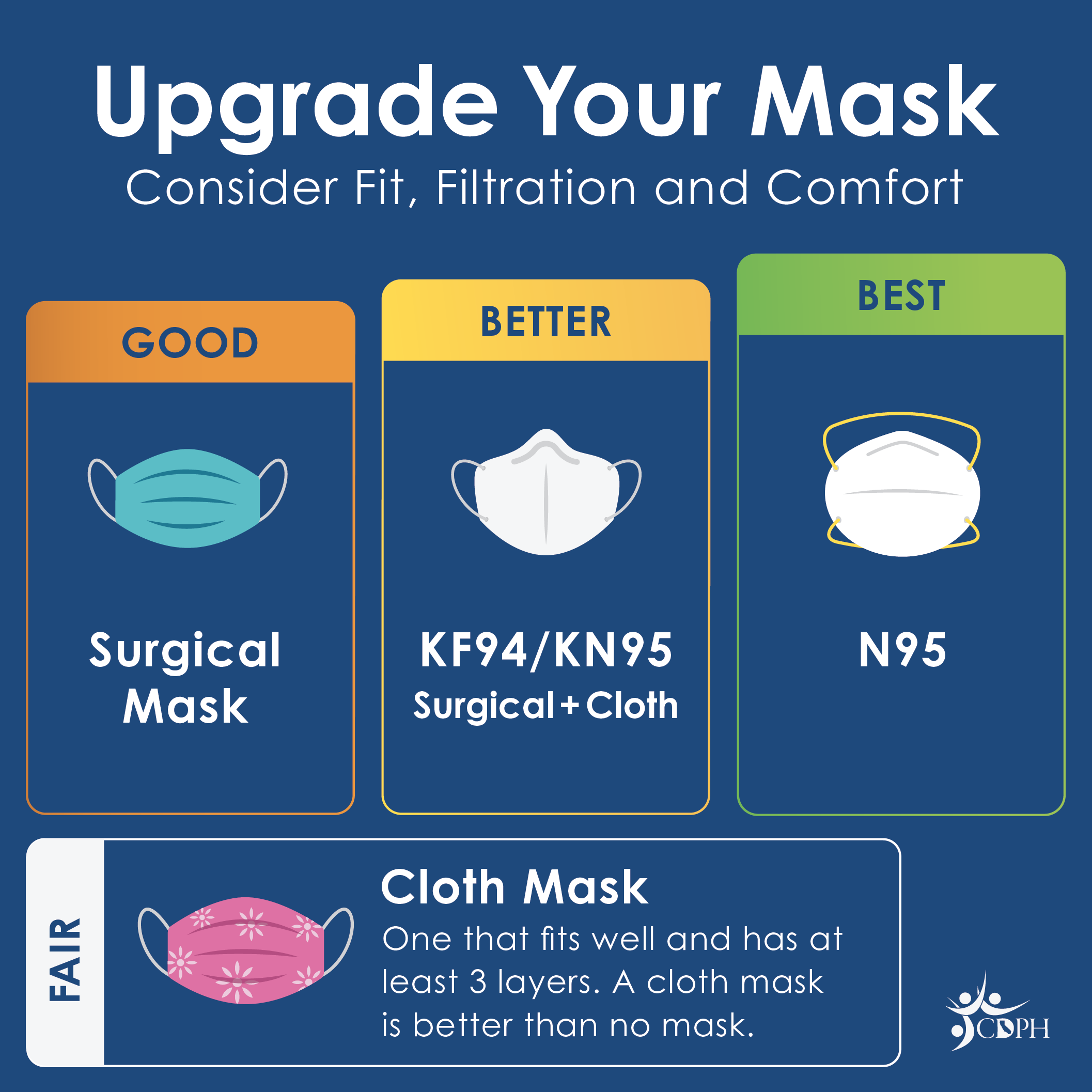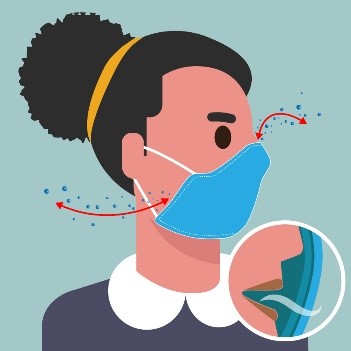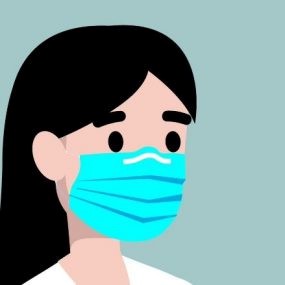
Wearing a mask is essential during the COVID-19 pandemic. It will help prevent both you and others from getting COVID-19. This is more important than ever with new, more easily transmitted variants of COVID-19 on the rise.
CDPH maintains updated
Guidance on the Use of Face Coverings in California and provides Tips and Resources on Masks for Kids.

Poor Fitting Face Covering
An effective mask has both
good fit and
good filtration. A well fitted mask has no gaps between the face and mask, such as above the nose or at the sides. With gaps, air that has virus particles can easily leak in or out around the sides of the mask. Good fit forces the air that you breathe out and breathe in to go through the mask and be filtered. Good filtration blocks the virus particles from going through the mask itself. You can get good filtration with the right materials and by using more layers.
Good fit and filtration improve protection for others if you are infected and protection for you if you are exposed to an infected person.
Double masking is an effective way to improve fit and filtration. A close-fitting cloth mask can be worn on top of a surgical/disposable mask to improve the seal of the mask to the face. Layering more than two masks is not recommended as this could be difficult to breathe through. Also, it is not recommended to wear two medical masks, or to wear a medical mask on top of a KN95, KF94, or N95. Double masking may be appropriate where improved fit and filtration are especially important, and some situations where this may be considered are listed below.
Regardless of the mask type, it is only effective if it is worn over your mouth and nose.
When Wearing an Effective Mask is Especially Important
Some situations require a higher level of protection (improved fit and/or improved filtration):
- In indoor settings with unvaccinated persons or with persons whose vaccination status is unknown.
- In indoor settings with poor ventilation.
- In close quarters with other people where social distancing is not possible (examples: riding a crowded bus, waiting in line at a crowded airport terminal).
- In any public place for people who are
older or with medical conditions that put them at
higher risk of severe COVID illness.
Even when you're at home, there are times when a higher level of protection is important, such as when:
- Providing care for family members who are sick with or may have been exposed to someone with COVID-19.
- Living in a household with someone who is suspected of having or has COVID-19.
- Someone from outside your household comes into your home who may be unvaccinated (example: friend, relative, repair person).
- You work outside the home and live with someone who is
older or with a medical condition that puts them at
higher risk of severe COVID illness.
As noted in the
CDC's Frequently Asked Questions about COVID-19 Vaccination, it is important to continue to wear a mask even after receiving the COVID-19 vaccine to protect yourself and others in some situations. It's important for everyone to continue using all the tools available to help stop this pandemic as we learn more about how COVID-19 vaccines work against evolving variants.
Choosing your Mask
Know which Masks Provide the Best Protection Against COVID-19:
-
N95 (also best for wildfire smoke)
| -
KF94
-
KN95
- Double Mask
- Fitted Surgical Mask
|
|
|
No matter what kind of mask you wear, check the fit and eliminate gaps above the nose or on the sides. Gaps will significantly reduce the effectiveness of any mask.
When they fit well, N95 respirators are highly effective in preventing the spread of COVID-19. Counterfeit N95s can be avoided by making sure they are NIOSH approved and have the required labeling (PDF) printed directly on the respirator.
Choose a size and model that fits your face and has no gaps. Test it by doing a seal check (PDF) to make sure it fits. N95 respirators are currently available online and in hardware and safety supply stores and are no longer being reserved for healthcare settings. As the availability of respirators increases, individuals may choose to wear them instead of other options, particularly in settings, such as those described above, where greater protection is needed.
If you wear an N95 respirator, you should not wear an additional face covering over or under the respirator, as it can interfere with the seal to the face.
KN95s and KF94s are international respirators that are designed to provide good filtration. However, testing of KN95s has shown that some models are not effective. For example, the National Institute for Occupational Safety and Health (NIOSH) has found that more than half of KN95s tested did not filter particles as well as the manufacturers claimed. If you do choose to use a KN95, we recommend finding a KN95 that has been
tested by NIOSH and has a minimum "filtration efficiency" of 95% or higher. Additionally, almost all KN95s and KF94s have ear loops. Respirators with ear loops often provide a worse fit than respirators with head straps (such as N95s), depending on head size and ear loop design.
KN95 and KF94s are both available in "child" or "extra-small" sizes, making them a good option for children.

Medical masks include various types of loose-fitting disposable masks. The fit of a medical mask can be improved with a simple modification or by using a mask brace (fitted). Look for the following when buying medical masks:
- Masks with three layers of non-woven material.
- An adjustable nose bridge.
- Surgical masks with ties may provide a closer fit than ear loops.
- Passed ASTM F2100; ASTM F2100 level 2 for higher filtration efficiency (American Society for Testing and Materials).
Cloth masks can only work well if they are tight fitting and made of materials that filter out small particles. Good cloth masks have:
- Two layers of tightly woven cotton with a third layer of non-woven fabric. The third layer could be a mask filter insert, or a synthetic fabric such as polypropylene.
- Nose wires to reduce gaps from the nose.
- Adjustable ear loops or straps that go around the head to reduce gaps from the face.
Face coverings without these properties should not be used in higher risk situations if other options are available. Examples of less effective face coverings are two-layer cotton masks, bandanas, and gaiters.
The CDC provides a list of commercially available face coverings that meet minimum filtration and breathability requirements (ASTM F3502-21). If purchasing a mask that conforms with American Society for Testing and Materials standards, choose a mask rated as "Level 2" which will provide better filtration than a Level 1 mask. A Level 1 mask has a filtration efficiency of at least 20% while a Level 2 mask has a filtration efficiency of at least 50%. The optional leakage ratio test provides additional information on the likelihood the mask will fit to provide an adequate seal to the wearer's face. Higher leakage ratios indicate a better fit.
Resources